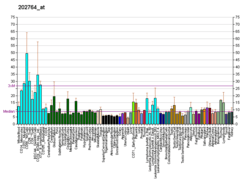STIM1
Stromal interaction molecule 1 is a protein that in humans is encoded by the STIM1 gene.[5][6][7] STIM1 has a single transmembrane domain, and is localized to the endoplasmic reticulum, and to a lesser extent to the plasma membrane.[8]
Even though the protein has been identified earlier, its function was unknown until recently. In 2005, it was discovered that STIM1 functions as a calcium sensor in the endoplasmic reticulum.[9][10] Upon activation of the IP3 receptor, the calcium concentration in the endoplasmic reticulum decreases, which is sensed by STIM1, via its EF hand domain. STIM1 activates the "store-operated" ORAI1 calcium ion channels in the plasma membrane, via intracellular STIM1 movement, clustering under plasma membrane and protein interaction with ORAI isoforms.[11][12][13] STIM1-mediated calcium entry is required for thrombin-induced disassembly of VE-cadherin adherens junctions.[14] 2-Aminoethoxydiphenyl borate (2-APB) and 4-chloro-3-ethylphenol (4-CEP) cause STIM1 clustering in a cell and prevent STIM1 moving toward plasma membrane.[15]
Interactions
STIM1 has been shown to interact with ORAI1, TMEM110 (STIMATE[16]), SERCA, TMEM66 (SARAF), and STIM2.[6]
References
- GRCh38: Ensembl release 89: ENSG00000167323 - Ensembl, May 2017
- GRCm38: Ensembl release 89: ENSMUSG00000030987 - Ensembl, May 2017
- "Human PubMed Reference:". National Center for Biotechnology Information, U.S. National Library of Medicine.
- "Mouse PubMed Reference:". National Center for Biotechnology Information, U.S. National Library of Medicine.
- Parker NJ, Begley CG, Smith PJ, Fox RM (Oct 1996). "Molecular cloning of a novel human gene (D11S4896E) at chromosomal region 11p15.5". Genomics. 37 (2): 253–6. doi:10.1006/geno.1996.0553. PMID 8921403.
- Williams RT, Manji SS, Parker NJ, Hancock MS, Van Stekelenburg L, Eid JP, Senior PV, Kazenwadel JS, Shandala T, Saint R, Smith PJ, Dziadek MA (Aug 2001). "Identification and characterization of the STIM (stromal interaction molecule) gene family: coding for a novel class of transmembrane proteins". The Biochemical Journal. 357 (Pt 3): 673–85. doi:10.1042/0264-6021:3570673. PMC 1221997. PMID 11463338.
- Williams RT, Senior PV, Van Stekelenburg L, Layton JE, Smith PJ, Dziadek MA (Apr 2002). "Stromal interaction molecule 1 (STIM1), a transmembrane protein with growth suppressor activity, contains an extracellular SAM domain modified by N-linked glycosylation". Biochimica et Biophysica Acta (BBA) - Protein Structure and Molecular Enzymology. 1596 (1): 131–7. doi:10.1016/S0167-4838(02)00211-X. PMID 11983428.
- Soboloff J, Rothberg BS, Madesh M, Gill DL (Sep 2012). "STIM proteins: dynamic calcium signal transducers". Nature Reviews Molecular Cell Biology. 13 (9): 549–65. doi:10.1038/nrm3414. PMC 3458427. PMID 22914293.
- Roos J, DiGregorio PJ, Yeromin AV, Ohlsen K, Lioudyno M, Zhang S, Safrina O, Kozak JA, Wagner SL, Cahalan MD, Veliçelebi G, Stauderman KA (May 2005). "STIM1, an essential and conserved component of store-operated Ca2+ channel function". The Journal of Cell Biology. 169 (3): 435–45. doi:10.1083/jcb.200502019. PMC 2171946. PMID 15866891.
- Liou J, Kim ML, Heo WD, Jones JT, Myers JW, Ferrell JE, Meyer T (Jul 2005). "STIM is a Ca2+ sensor essential for Ca2+-store-depletion-triggered Ca2+ influx". Current Biology. 15 (13): 1235–41. doi:10.1016/j.cub.2005.05.055. PMC 3186072. PMID 16005298.
- Putney JW (Sep 2009). "Capacitative calcium entry: from concept to molecules". Immunological Reviews. 231 (1): 10–22. doi:10.1111/j.1600-065X.2009.00810.x. PMID 19754887.
- Zhou Y, Srinivasan P, Razavi S, Seymour S, Meraner P, Gudlur A, Stathopulos PB, Ikura M, Rao A, Hogan PG (Aug 2013). "Initial activation of STIM1, the regulator of store-operated calcium entry". Nature Structural & Molecular Biology. 20 (8): 973–81. doi:10.1038/nsmb.2625. PMC 3784406. PMID 23851458.
- Ma G, Wei M, He L, Liu C, Wu B, Zhang SL, Jing J, Liang X, Senes A, Tan P, Li S, Sun A, Bi Y, Zhong L, Si H, Shen Y, Li M, Lee MS, Zhou W, Wang J, Wang Y, Zhou Y (2015-07-17). "Inside-out Ca(2+) signalling prompted by STIM1 conformational switch". Nature Communications. 6: 7826. doi:10.1038/ncomms8826. PMC 4509486. PMID 26184105.
- Soni D, Regmi SC, Wang DM, DebRoy A, Zhao YY, Vogel SM, Malik AB, Tiruppathi C (Apr 2017). "Pyk2 Phosphorylation of VE-PTP Downstream of STIM1 induced Ca2+ entry Regulates Disassembly of Adherens Junctions". American Journal of Physiology. Lung Cellular and Molecular Physiology. 312 (6): L1003–L1017. doi:10.1152/ajplung.00008.2017. PMC 5495943. PMID 28385807.
- Zeng B, Chen GL, Xu SZ (Oct 2012). "Store-independent pathways for cytosolic STIM1 clustering in the regulation of store-operated Ca(2+) influx". Biochemical Pharmacology. 84 (8): 1024–35. doi:10.1016/j.bcp.2012.07.013. PMID 22842488.
- Jing J, He L, Sun A, Quintana A, Ding Y, Ma G, Tan P, Liang X, Zheng X, Chen L, Shi X, Zhang SL, Zhong L, Huang Y, Dong MQ, Walker CL, Hogan PG, Wang Y, Zhou Y (Aug 2015). "Proteomic mapping of ER-PM junctions identifies STIMATE as a regulator of Ca(2+) influx". Nature Cell Biology. 17 (10): 1339–47. doi:10.1038/ncb3234. PMC 4589512. PMID 26322679.




